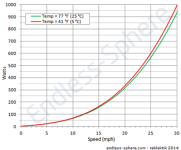Busybee
100 µW
I recently became aware of a cycle power calculator, Powercalc, shareware with an obnoxious nag screen, from http://www.machinehead-software.co.uk/cycling.html
It is for bicyclists but includes power in watts required under specified conditions. The ebike.ca simulator has to calculate the load wattage which is independent of power source, and so the two simulators should give similar results. The Powercalc program, however, does not agree with the ebike.ca simulator especially on zero slope comparisons. This is of concern because claims by some ebike manufacturers may be based on Powercalc estimates.
Assuming the Powercalc default of an 85 km (187 lbs) bike/rider on a race bike in a tuck position using 700c wheels, the two simulators are in reasonable agreement assuming a 10% slope (Powercalc being 1% to 12% lower for speeds from 5 mph to 30 mph respectively), and in lessor agreement assuming a 5% slope (Powercalc being 5% to 18% lower for speeds from 5 mph to 30 mph).
The big difference however was at 0% slope. Powercalc was 36% to 44% lower, but unlike on slopes, the Powercalc estimate was lowest assuming lower speed. This is bad as most ebike claims are based on travel on flatland. The only certainty is that both simulators can't be correct.
If some ebike manufacturers are using the known output of their motor and using Powercalc to estimate speed, then claimed range and speed would be quite a bit more than the ebike.ca simulator would predict.
Since ebike.ca also has plenty of Cycle Analysts to check their simulator against real world performance, I'll bet Powercalc is the one more in error. Still, could explain where some of the inflated claims may come from.
It is for bicyclists but includes power in watts required under specified conditions. The ebike.ca simulator has to calculate the load wattage which is independent of power source, and so the two simulators should give similar results. The Powercalc program, however, does not agree with the ebike.ca simulator especially on zero slope comparisons. This is of concern because claims by some ebike manufacturers may be based on Powercalc estimates.
Assuming the Powercalc default of an 85 km (187 lbs) bike/rider on a race bike in a tuck position using 700c wheels, the two simulators are in reasonable agreement assuming a 10% slope (Powercalc being 1% to 12% lower for speeds from 5 mph to 30 mph respectively), and in lessor agreement assuming a 5% slope (Powercalc being 5% to 18% lower for speeds from 5 mph to 30 mph).
The big difference however was at 0% slope. Powercalc was 36% to 44% lower, but unlike on slopes, the Powercalc estimate was lowest assuming lower speed. This is bad as most ebike claims are based on travel on flatland. The only certainty is that both simulators can't be correct.
If some ebike manufacturers are using the known output of their motor and using Powercalc to estimate speed, then claimed range and speed would be quite a bit more than the ebike.ca simulator would predict.
Since ebike.ca also has plenty of Cycle Analysts to check their simulator against real world performance, I'll bet Powercalc is the one more in error. Still, could explain where some of the inflated claims may come from.


